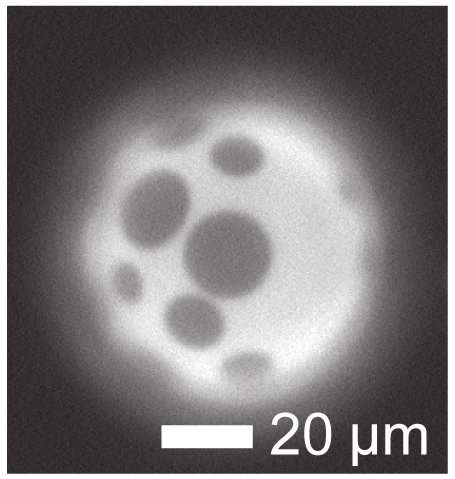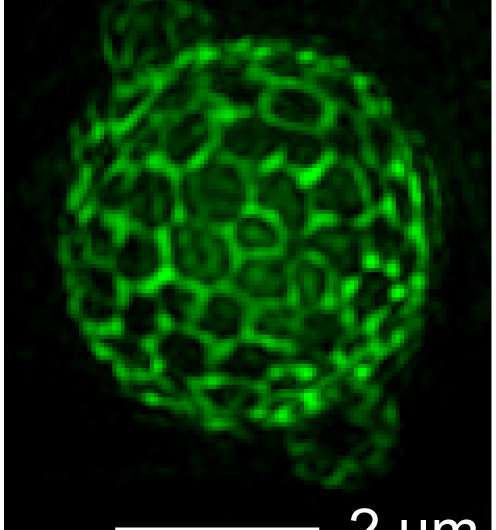Living cell membranes can self-sort their components by 'demixing'

Cells—the building blocks of our bodies—are encapsulated by membranes. The same goes for the specialized compartments within our cells.
These membranes are extremely thin, oily films, containing proteins and fatty molecules called lipids. For decades, scientists have argued about how cell membranes organize and maintain distinct regions enriched in particular protein and lipid types. These regions are thought to influence cellular activities, such as the signaling that controls both normal cellular growth and the growth of cancerous cells.
In a paper published Dec. 5 in the Biophysical Journal, scientists at the University of Washington show for the first time that the complex distribution of molecules within a membrane of a living yeast cell arises through demixing. Also known as phase separation, demixing is a simple physical process that is similar to the action that causes droplets of oil to separate from vinegar in a salad dressing.
"Cells have a toolbox with a variety of resources to help them complete a variety of tasks," said senior author Sarah Keller, a UW professor of chemistry. "By teaming up with Alex Merz, a UW professor of biochemistry and a yeast expert, we've shown that phase separation is one of those tools to shape membranes and their functions within a living system."

The UW researchers were inspired by pictures of a genetically engineered strain of yeast in which membrane proteins fluorescently glowed. The proteins lit up intracellular, membrane-bound compartments called vacuoles. The vacuoles looked like miniature green balls patterned with dark polka dots. Those polka dots, the researchers realized, looked nearly identical to membrane regions that arise from phase separation in two types of non-living systems: simple, artificial membranes created in a lab and membranes shed from cells under severe stress.
"The membranes of living systems contain many different types of fats, proteins and other molecules," said co-lead author Scott Rayermann, a lecturer at UW Tacoma who conducted this research when he was a UW doctoral student in chemistry. "Each of these types of molecules harbors different physical and chemical properties with the potential to affect the properties of the membrane as a whole. We and other groups have hypothesized that this variety of molecules would allow membranes to phase separate by composition into discrete regions."
First, the team discovered that the polka dots that appear on vacuole membranes can merge quickly. This behavior is consistent with fluid phases, just as droplets in a recently-shaken oil and vinegar salad dressing quickly coalesce when they collide. Next, the team found that phase separation in the membranes of yeast vacuoles depends on temperature. When the researchers warmed the yeast above 90 degrees Fahrenheit, the two liquid phases merged into one—the polka dots vanished. As the yeast cells were cooled back to room temperature, the phase-separated regions reappeared.

"Scientists had never previously shown that phase-separated liquids can co-exist in the membranes of living cells," said co-lead author Glennis Rayermann, a UW doctoral student in chemistry. "To show that phase separation occurs, we had to reliably track the distribution of proteins within membranes, show that they formed regions like in artificial systems and that these regions would merge in response to changing environmental conditions."
Now that the researchers have shown that living membranes can undergo phase separation, future work is needed to show how cells regulate phase separation. This could be through the action of genes, environmental conditions or a combination of factors.
"Our finding that phase separation can drive membrane organization in yeast suggests that similar processes may operate in other cells, including human cells," said Merz. "Again, we see the power of model systems such as yeast, fruit flies and worms in our exploration of fundamental physiology. UW has been at the forefront of yeast genetics and cell biology for over 60 years."
"There is incredible potential here to unlock how different types of cells form and maintain unique structures—and how different structures are formed even within the same cell," said Keller.
More information: Scott P. Rayermann et al, Hallmarks of Reversible Separation of Living, Unperturbed Cell Membranes into Two Liquid Phases, Biophysical Journal (2017). DOI: 10.1016/j.bpj.2017.09.029
Journal information: Biophysical Journal
Provided by University of Washington



















